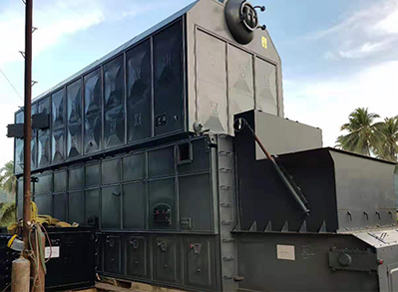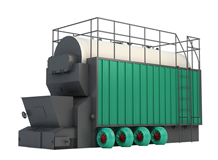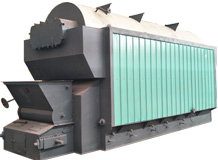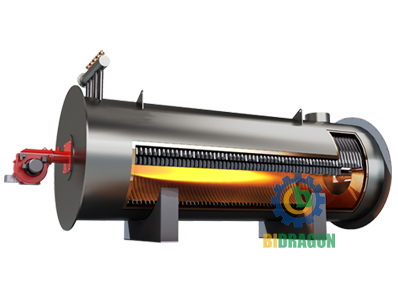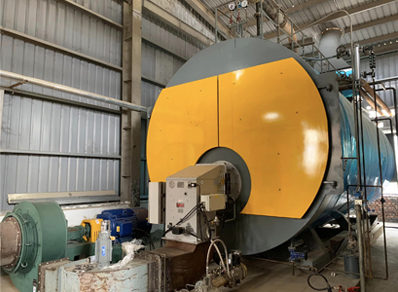
A Comprehensive Guide to Steam Boilers
In the modern society we live in, steam boilers are like a hero behind the scenes, quietly providing indispensable power support for many areas. Whether in the heat of the factory floor, or in the warmth and comfort of the hotel interior, the figure of the steam boiler can be seen everywhere, playing a key role. Next, let's delve deeper into the mysteries of the steam boiler and learn about its basic concepts, types, components and wide range of applications.
The Definition of Steam Boiler
A steam boiler is essentially a closed vessel. Its core task is to use the heat generated by the combustion of fuel, water into steam. This process may seem simple, but it contains complex physical and chemical principles. Steam has a wide range of uses in industry and commerce, from common heating to large-scale power generation, all of which are dependent on the operation of a steam boiler.
The work of a steam boiler begins with the combustion of fuel in a combustion chamber. When the fuel is ignited, hot gases are produced. These hot gases carry a lot of heat energy, which is next exchanged with the water surrounding the combustion chamber. As the heat continues to be transferred, the water absorbs enough energy to gradually increase in temperature until it reaches the boiling point, where it begins to boil and convert to steam. This process continues week after week, continuously providing steam for each application.
The Types of Industrial Steam Boilers
Fire Tube Boiler
Fire tube boilers utilize a unique design where the main body is a cylindrical shell filled with water. The high-temperature gases from combustion do not come into direct contact with the water, but flow through tubes arranged inside the boiler. This design allows the high temperature gases to transfer heat to the surrounding water as they flow through the tubes, resulting in the heating of the water and the production of steam. Advantages include its compactness and simplicity of design, its ability to transfer heat quickly, and its adaptability to many different steam requirements.
Water Tube Boiler
Water tube boilers have a different design concept than fire tube boilers. In a water tube boiler, it is water that fills the tubes and the high temperature combustion gases flow around these tubes. The water tubes are usually arranged in a spiral or parallel arrangement, and this design can greatly improve the efficiency of heat transfer. Its advantage lies in the ability to produce a higher amount of steam, but also can withstand high pressure.
Electric Boiler
The electric boiler is a device that uses electricity to generate steam. It is fitted with resistance heating elements inside which are submerged in water. When the current passes through the resistance heating element, the electrical energy is converted into thermal energy, making the element heat, and then the surrounding water is heated and converted into steam. This way of working allows the electric boiler to operate without any direct pollutant emissions. Its advantages are very obvious, not only energy efficient, but also very suitable for small-scale applications.
The Important Components and Functions of the Steam Boiler System
Burner
The burner plays a key role in the steam boiler system. When the boiler's temperature control system detects that the water temperature is below the set value, the thermostat sends a signal to the burner. The burner then starts to work, sending fuel in the form of spray through the oil pump into the combustion chamber and igniting it. During the combustion process, according to the size of the heat required by the system, the burner will automatically adjust the amount of fuel spray to ensure the adequacy and stability of combustion and provide a continuous source of heat for the steam boiler.
Piping
The piping in a steam boiler is divided into two types: water tube and fire tube, both of which serve to realize the transfer of heat and water. In a water tube boiler, water flows inside the tubes and high temperature gases surround the outside of the tubes, exchanging heat through the walls of the tubes to warm the water and convert it into steam. In a fire-tube boiler, the opposite is true, with high-temperature gases flowing inside the tubes and transferring heat to the water outside the tubes. Regardless of the type of pipe, its good thermal conductivity and reasonable arrangement are important factors in ensuring the efficient operation of a steam boiler.
Pressure Vessel
Pressure vessel is an important part of the steam boiler, it needs to have the ability to withstand high temperature and pressure. In the steam boiler operation process, the high temperature and high pressure steam and combustion of high temperature and high pressure gas are contained in the pressure vessel. The material and structural design of the pressure vessel must be rigorously calculated and tested to ensure safe and reliable operation under various operating conditions and to prevent leakage or explosion and other dangerous situations.
Combustion Chamber
Combustion chamber is the place of fuel combustion, is the source of heat generated by the steam boiler. Fuel mixed with air in the combustion chamber and ignited, releasing a large amount of heat energy. The design of the combustion chamber needs to take into account the type of fuel, combustion efficiency and heat distribution and other factors to ensure that the fuel can be fully combusted, and the heat generated can be effectively transferred to the surrounding water or heat exchange media.
Controller
The controller is the intelligent brain of the steam boiler system, which is responsible for monitoring and regulating the operation of the entire system. Through the sensor real-time acquisition of boiler temperature, pressure, water level and other parameters, the controller can be based on the preset program on the burner, pumps and other equipment for automatic control, to ensure that the boiler is running in the best state. In addition, the controller also has a remote monitoring function, the operator can view and adjust the boiler's operation in real time through the network at the remote terminal. At the same time, in the event of anomalies, the controller is able to issue timely alarms and take appropriate protective measures, such as emergency shutdown, in order to protect the safety of equipment and personnel. In chemical water treatment, the controller also plays an important role, it can automatically control the amount of chemicals added according to the water quality monitoring data, to ensure the quality of the boiler water, to prevent equipment corrosion and scaling caused by water quality problems and other failures.
Heat Exchanger
The main function of the heat exchanger is to realize the transfer of heat from one medium to another, and the two media are not in direct contact with each other. In the steam boiler system, the heat exchanger is usually used to transfer the heat from the high temperature gas produced by combustion to the water inside the boiler, so as to realize the heating of water and the generation of steam. The design and material selection of the heat exchanger has a significant impact on the heat transfer efficiency and the service life of the equipment. Highly efficient heat exchangers can ensure the heat transfer effect at the same time, reduce energy waste and improve the overall performance of the steam boiler system.
Feed Water Tank
Feed water tank is a steam boiler water storage device. In order to ensure the normal operation of the steam boiler and the quality of steam, the water into the water tank must undergo strict treatment to remove impurities, hardness ions and other harmful substances. The treated water is stored in the feedwater tank, and when the boiler needs to be replenished, the water in the feedwater tank is transported to the inside of the boiler through the water pump. In the process of steam use, part of the steam will be condensed into water, and this condensate is returned to the feed water tank through the condensate return pipeline, realizing the recycling of water resources and reducing the production cost and the waste of water resources.
Energy Saver
Energy saver as an important energy saving equipment in the steam boiler system, its working principle is similar to the heat exchanger. It is mainly used to capture the waste heat in the boiler exhaust and transfer this waste heat to the boiler feed water. In this way, heat that would otherwise be discharged into the atmosphere is recycled, improving the energy utilization of the steam boiler system and reducing energy consumption and exhaust emissions. The installation of the energy saver not only helps to reduce the operating costs of the enterprise, but also meets the current environmental requirements of energy conservation and emission reduction, which is of great significance in promoting sustainable development.
The Industry to Benefit From the Steam Boiler
The Chemical Industry
In chemical production, many chemical reactions need to be carried out at specific temperatures and pressures, steam boilers provide high-temperature and high-pressure steam to meet these process requirements for heating, distillation, and heat supply in the chemical reaction process.
Food Processing Industry
Food processing industry on health and safety requirements are extremely high, steam boilers play a vital role here. Through the high temperature and pressure of steam, food processing equipment, packaging materials, etc. can be sterilized to ensure that the food in the production process of health and safety. At the same time, steam is also widely used in the cooking, baking, steaming and other processing of food, which can ensure the taste and quality of food.
Pharmaceutical Industry
In the pharmaceutical process, the sterility of the environment is extremely strict. Steam boilers produce high-temperature steam can be used for pharmaceutical equipment, drug packaging and production workshop sterilization, to create a sterile environment for the production of drugs to ensure the quality and safety of drugs.
Medical Industry
Hospitals and other medical facilities are also inseparable from the steam boiler. On the one hand, steam is used in the heating system to provide a warm and comfortable environment for all areas of the hospital. On the other hand, in the process of sterilization of medical equipment, high temperature and high pressure steam can effectively kill bacteria and viruses to ensure the safe use of medical equipment and prevent the occurrence of cross-infection.
Hotels, Education and Government Buildings
In hotels, schools and government office buildings, steam boilers are mainly used for heating and providing domestic hot water. During the cold winter months, steam is piped to the radiators in each room to provide warmth inside. At the same time, hot water is also required in the kitchens and laundries of hotels, and steam boilers are able to meet these hot water needs and ensure that all services in the building operate properly.
Oil Industry
In the process of oil extraction and processing, high-pressure steam boilers are used to generate hot water and steam for drilling operations to provide the necessary power and heat support, while also playing an important role in the oil refining process.
Conclusion
As an important industrial equipment, steam boiler plays an irreplaceable role in various fields. From its basic definition, the characteristics of different types, to the function of system components and a wide range of industrial applications, we can see that steam boilers play a vital role in the production and life of modern society. With the continuous progress of science and technology, the performance and efficiency of the steam boiler is also improving, and it will continue to provide strong support for the development of various industries in the future. If you have more questions about steam boilers or want to know more detailed information, please feel free to contact us, we will be happy to serve you.

